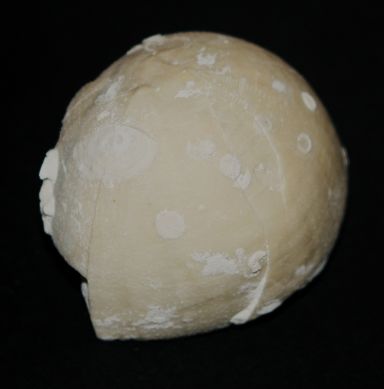This fossilised sea urchin was given to my 7-year old daughter by fossil-hunters on the beach at Birling Gap, Beachy Head. Over thousands of millennia it has turned to a tough chalk, typical of the fossils of the Southern England Chalk Formation. It may well be the same genus as this Echinocorys, which was found at nearby Seaford and dates from the Cretaceous Period.
Sea creatures are generally associated with the mysterious, the erotic, the irrational: all the stuff of the Shoreline. And they were everywhere you looked in the work of the Surrealists. However, I was uncertain what to make of this particular creature. An online search for sea urchin symbolism directed me to Rene Guenon’s The Great Triad, the first 40 pages or so of which you can read for free on Google Books, though posting a direct link defeats me. On pages 29-34 he discusses the World Egg, a symbol that occurs in many traditions: the Cosmic Egg which contains both Heaven and Earth, and as such represents the alchemist’s quest for self-transformation. The egg is associated with serpents:
And that footnote 11 says…
Well now. Not just a sea urchin, but a fossil sea-urchin. My daughter had been given an egg of the Cosmic Serpent: Ouroboros, the serpent that eats its own tail. Symbol of renewal, recurrence, and immortality: life begetting life.
The Ouroboros, or something very like it, occurs in so many ancient traditions that Jung considered it an archetype, an expression of something fundamental in both the collective psyche and the alchemical process:
The alchemists, who in their own way knew more about the nature of the individuation process than we moderns do, expressed this paradox through the symbol of the Ouroboros, the snake that eats its own tail. The Ouroboros has been said to have a meaning of infinity or wholeness. In the age-old image of the Ouroboros lies the thought of devouring oneself and turning oneself into a circulatory process, for it was clear to the more astute alchemists that the prima materia of the art was man himself. The Ouroboros is a dramatic symbol for the integration and assimilation of the opposite, i.e. of the shadow. This ‘feed-back’ process is at the same time a symbol of immortality, since it is said of the Ouroboros that he slays himself and brings himself to life, fertilizes himself and gives birth to himself. He symbolizes the One, who proceeds from the clash of opposites, and he therefore constitutes the secret of the prima materia which […] unquestionably stems from man’s unconscious. (Jung, Mysterium Coniunctionis).

The serpent endlessly renews itself: yet something is missing. Nothing new is happening: the cycle simply repeats and repeats. But this is where the egg comes in- by the serpent’s production of the egg, novelty and change are introduced: the possibility of progress.
I know little about Rene Guenon. His assertion that the fossil sea-urchin represents the serpent’s egg is unreferenced and I have been unable to find a source, although this page also identifies the sea urchin (though not fossilised specifically) as representing “the serpent’s cosmic world-creating seed… the ‘serpent’s egg‘”, while The Continuum Encyclopedia of Animal Symbolism in Art has this to say:

So there does appear to be a precedent for Guenon’s association of the urchin and the serpent’s egg.
To understand this fully, however, we must consider what actually happened when the fossil was given to my daughter.
Being my daughter, she is familiar with fossils, and was intrigued by the fossil-hunters at Birling Gap, and keen to see what they were up to. They had found three fossil urchins that day, and presented her with the best-preserved of the three. In other words, we have here a deep symbol, one of the very deepest: an ancient idea that recurs across times and cultures, an image that encrypts the secret of alchemy. But most significantly, this symbol became manifest on the Shoreline through two enabling processes:
the curiosity of a child
and
the kindness of strangers
Consider this well – and keep hope in your heart.





Pingback: Le Dauphin Acephale | The Haunted Shoreline
Pingback: Short Report from the Frontline | The Haunted Shoreline
Pingback: Lodestones of Antivenom | The Haunted Shoreline
Pingback: The Mudlark | The Haunted Shoreline
Pingback: A Helix Of Slime | The Haunted Shoreline
Pingback: Psychedelic Omnivision | The Haunted Shoreline
Thank you for directing me here. Lovely article, and a topic close to my heart; if you look at the header for my blog, you can see two tiny images of the world egg there, with Rebis the Hermaphrodite, union of the opposites, inside 🙂
I enjoy your site and its closeness to the cold and wet reality of the shoreline. I envision a philosopher in rubber boots.
Thanks for that. No rubber boots- not so good for scrambling over the rocks. I wear an old pair of trainers for my Shoreline wanderings: the sea salt gets into them and makes little maps of the imaginal realm.
Pingback: Heavy Metal | The Haunted Shoreline
Pingback: The Shaken Kaleidoscope | The Haunted Shoreline
Pingback: Elephant Hawk Serpent | The Haunted Shoreline
Pingback: The Whitening Crow | The Haunted Shoreline
Pingback: As Above, So Below | The Haunted Shoreline
Pingback: An Easter Egg | The Haunted Shoreline
Pingback: The Saint and the Serpent | The Haunted Shoreline
Pingback: The Wheel Of Fortune: Springtime For Anubis | The Haunted Shoreline
Pingback: To See A World… | The Haunted Shoreline
So inspiring to read, studying up on alchemy. Thank you.